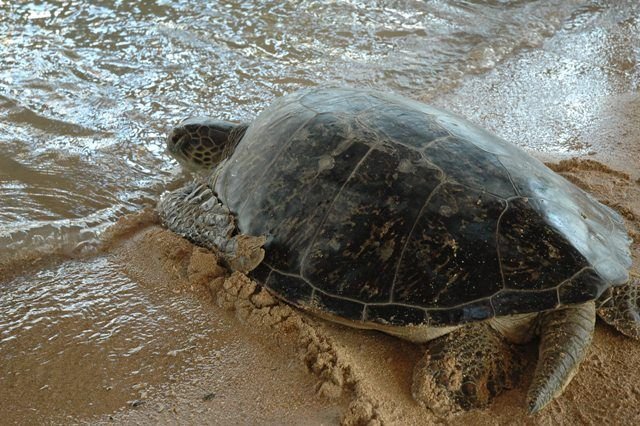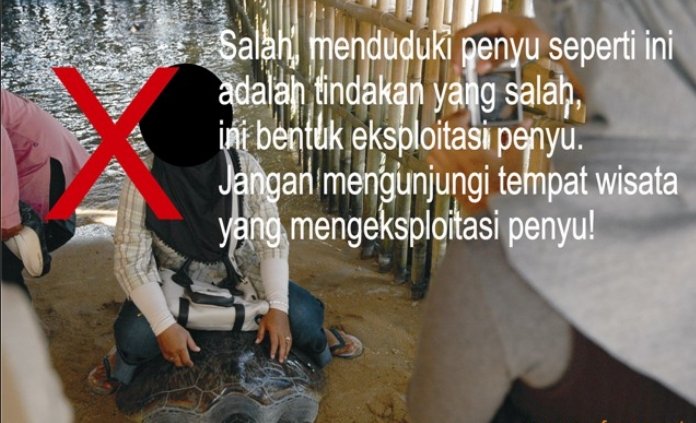
Have you ever observed turtles laying eggs? Observing turtles laying eggs is a very rare and amazing experience. However, observation without specific guidance can greatly interfere with the turtle egg breeding process. It could be that the turtles will not let their eggs to lay their eggs because they are disturbed by the people who observe them.
Follow the simple instructions below to avoid disruption of the turtle nesting process:
All types of turtles in Indonesia are protected by Law No. 5 of 1990 and Government Regulation No. 7 of 1999. There are 7 species of turtles in the world (some experts say 8), and 6 of them are in Indonesian waters ;
- Green Turtle (Chelonia mydas), or Green Sea Turtle.
- Turtle Lekang (Lepidochelys olivacea), or Olive Ridley Sea Turtle.
- Hawksbill Turtle (Eretmochelys imbricata), or Hawksbil Sea Turtle.
- Leatherbacks (Dermochelys coriacea), or Sea Turtle leatherback.
- Loggerhead turtle (Caretta caretta), or Loggerhead Sea Turtle.
- Flattened turtle (Natator depresus), or Flatback Sea Turtle.
Loggerhead turtles and Flattened turtles can be found in Indonesian waters but there is no news that they are nesting in the islands of Indonesia. Here are two more turtle species not found in Indonesia:
Kempi Turtle (Lepidochelys kempii) Kemps Sea Turtle. The original habitat is on the Mexican coast, categorized as the most endangered and the most protected turtle in the world. Some experts say that hawksbill is the smallest turtle.
Black Turtle (Chelonia sp) Black Sea Turtle. Actually there is no mention in the Indonesian language because the experts argue about whether the Black Turtle is still a clan with Green Turtle or not. The black turtle has identical features that are exactly the same as the Green Turtle, but what distinguishes is the darker color of the Black Turtle.

As animals that have been protected by Indonesian and international law, every citizen is responsible for treating turtles with caution. Turtles and hatchlings (baby / baby turtle) can not be treated as pets, commercialized, and exploited (eg climbed / occupied for the sake of tourism). Here is a basic knowledge and guidance on observing turtles.
The Facts About the Turtle:
All types of turtles face extinction if not protected.
It is not true that the number of turtles is abundant.
Turtle is breathing with the lungs.
In turtle sleep conditions can sleep up to 4 hours under water (some experts say 7 hours), in an active state the turtle must take air every 30 minutes.
But in a state of stress due to a fishing net netted for example, the turtle can faint within 10 minutes in the water.
Plastic waste endanger the life of turtles, especially if the plastic is thought to be the favorite jellyfish turtle food. M
Turtles will always return to where they hatch to lay eggs, but if the place has been damaged then most likely the turtle will not return.
What You Can Do
There are a few things you should look at carefully when you are in a turtle habitat area or when you are dealing with turtles, among others:
While In Water:

Be careful when carrying a motorized boat, especially fast boat (speed boat).
Boat crashes to turtles can kill turtles.
The most probable case is that the turtles are ripped apart by boat propellers.
While in the water, pay attention to your distance with turtles.
Take care that you do not surprise the turtles or disturb the turtles that are resting, sleeping, even the turtles that are eating.
If you want to make observations, approach them very slowly, and stay away from turtles if they show signs of fear.
Never spear, catch, harass, play and occupy the turtle !.
Experts say not to touch or feed the turtles.
Do not throw garbage carelessly, garbage can endanger the main turtle if the turtle is consumed because it is thought of jellyfish.
While on the Beach:
Avoid spoiling the turtle nest! Do not drive, exercise, play, and camp in the turtle landing area.
Be careful with the fire! The light from the campfire will attract the newly hatched hatch to approach and die from roasting.
Do not leave big objects on turtle landing beaches such as umbrellas, chairs, cooler boxes and others, as they may disturb the turtles and undo the turtle nesting process.
Take care of your animals, especially dogs, because dogs can harm eggs and hatchlings (baby turtles) When on the beach, keep the lights up to be as luminous as possible, it is recommended to use a red light.
The lights can make the crocks confused and can turn from the water to the land.
Cover the lights so that they are not visible from the beach, because the lights can be frightening to the turtle nests that are ready to lay their eggs.
Guide to Conducting a Sea Turtle Observation

Observing the turtle nesting eggs is a very rare experience. However, observation without specific guidance can be very disturbing the process of spawning sea turtles. Follow the simple instructions below to avoid disruption of the spawning process:
Reduce the noise to the minimum, stay calm and move slowly.
Do not approach the turtle that has just landed, because at this moment the level of turtle awareness is at the highest level.
Turtles can become frightened and turn to the sea.
Indigenous turtles that have not spawn should be left alone, should not be approached.
Minimize the use of a flashlight, preferably using a red light. Do not direct the light directly to turtle parent face.
Slow back slowly if turtles experience signs of fear.
Not to disturb the hatchling when it is encountered with a hatchling when observing the turtle laying eggs.
Should not disturb the nest and eggs of the turtle nesting eggs.
Try not to observe more than 30 minutes.
Never take a photo with blinking lights, before turtle nesting eggs.
Blits are very annoying turtle breeding.
Just taking photos from behind, the turtles hit by the blits lights will be temporarily blind and disturb the turtles in finding their way back to the sea.
About Tukik

If the hatchling looks confused because the lights of the city, hometown or hotel then all you can do is one person covering the light with and staying behind the hatchling.
While the other person leads the turtle to the sea by standing between the tug and the sea with the back to the sea position, direct the flashlight to the piercing face and slowly retreat toward the sea.
Tukik will follow the light of a flashlight, do it until the suction touches the water.
Do not disturb, touch the hatchling, or pick up the hatchling with the aim of helping him towards the water.
Tukik must walk alone to the water.
Do not photograph the hatchlings that hatch at night with blits lights because they are very sensitive to light blits.
Here is my little knowledge of turtles, we must protect endangered turtles. Useful for our children and grandchildren to know this animal and enjoy its beauty therefore our duty to preserve turtles and other animals to avoid extinction.